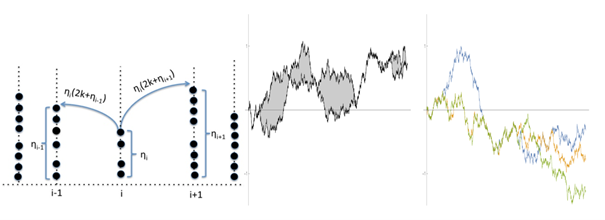Inclusion Process and Sticky Brownian Motions

The ninth “One World webinar” organized by YoungStatS will take place on February 9th, 2022. Inclusion process (IP) is a stochastic lattice gas where particles perform random walks subjected to mutual attraction. For the inclusion process in the condensation regime one can extract that the scaling limit of two particles is a pair of sticky Brownian motions which lead to interesting recent research. In a system of sticky Brownian motions, particles behave as independent Brownian motions when apart, but have a sticky interaction when they meet. Recently, exact formulas for specific types of sticky interactions have been derived.
Both the Inclusion process and the system of Sticky Brownian motions satisfy a form of self-duality.
Selected young researchers active in this area of probability and stochastic processes will present their contributions on these topics.
When & Where:
- Wednesday, February 9th, 9:00 PT / 12:00 EST / 18:00 CET
- Online, via Zoom. The registration form is available here.
Speakers:
- Mario Ayala, Centre INRAE PACA, Avignon, France. “Condensation of SIP particles and sticky Brownian motion”.
Abstract: In this talk we will first introduce the symmetric inclusion process (SIP) in the condensation regime. We will describe how to obtain, with the help of self-duality, an explicit scaling for the variance of the density field in this regime, when initially started from a homogeneous product measure. This provides relevant new information on the coarsening dynamics of condensing interacting particle systems on the infinite lattice. We obtain our result by proving convergence to sticky Brownian motion for the difference of positions of two SIP particles in the sense of Mosco convergence of Dirichlet forms.
- Dominic Brockington, University of Warwick, United Kingdom. “Fluctuations in the Howitt-Warren process”.
Abstract: Because of their consistency, sticky Brownian motions can be constructed as conditionally independent processes in a common random environment. The law of one such process, conditioned on the environment, is called the Howitt-Warren process. The Howitt-Warren process can also be viewed as the density of an infinite number of sticky Brownian motions. In the exactly solvable case, we study the fluctuations of this process in the large time limit.
- Mark Rychnovsky, University of Southern California, USA. “Extremal particles for sticky Brownian motions.”
Abstract: Sticky Brownian motions behave as independent Brownian motions when they are separated and interact when they touch, so that the coincidence time has positive Lebesgue measure with positive probability. For a specific sticky interaction we will show that as time and the number of particles are simultaneously sent to infinity, The fluctuations of the extremal particle are given by the GUE Tracy-Widom distribution. The proof involves realizing a specific sticky interaction as the limit of an exactly solvable statistical mechanics model, the Beta random walk in random environment, and using this to derive exact formulas.
- Stefan Wagner, Ludwig-Maximilians University Munich, Germany. “The Inclusion Process on General Spaces: Reversible Measures, Consistency and Self-Duality”.
Abstract: The symmetric inclusion process is a well-known process describing particles hopping on a discrete set. In this talk, we want to define an analogue dynamics on an arbitrary non-discrete space (e.g. \(\mathbb{R}^d\)). We consider whether properties like the existence of a reversible measure, consistency and self-duality can be transferred. Regarding the last point, we obtain a general machinery that can also be applied to other consistent particle systems (e.g. sticky Brownian motion) on general spaces.
Discussant:
- Simone Floreani, Delft University of Technology, The Netherlands
The webinar is part of YoungStatS project of the Young Statisticians Europe initiative (FENStatS) supported by the Bernoulli Society for Mathematical Statistics and Probability and the Institute of Mathematical Statistics (IMS).
If you missed this webinar, you can watch the recording on our YouTube channel.